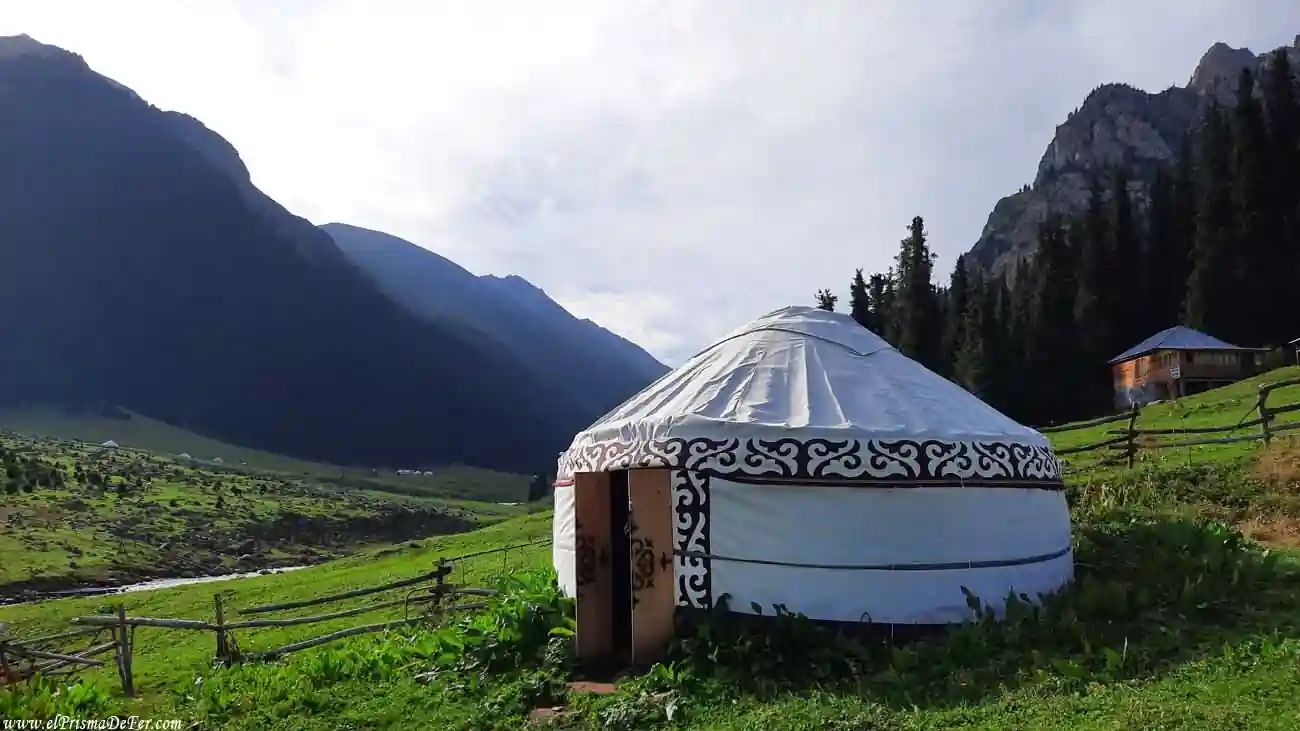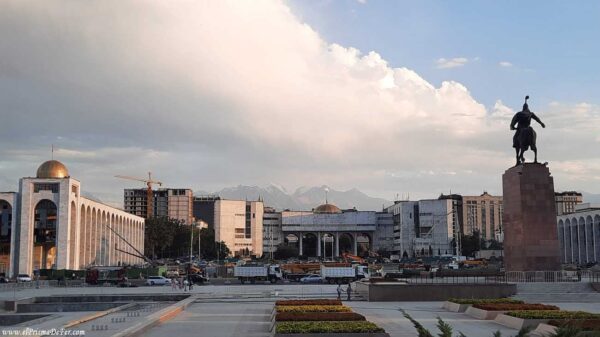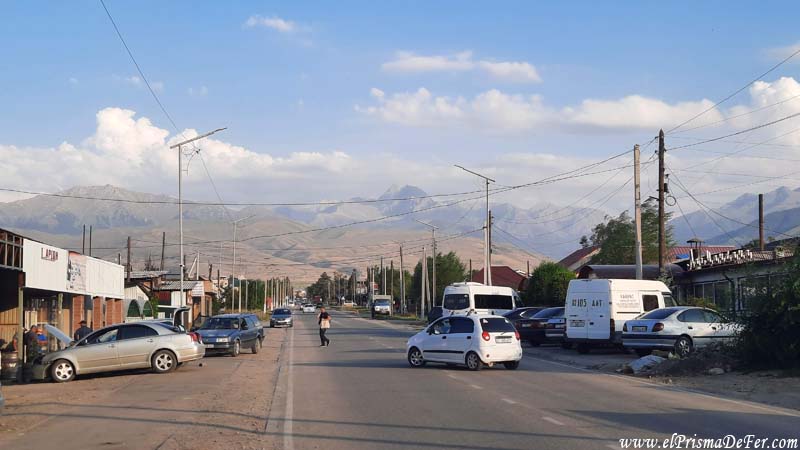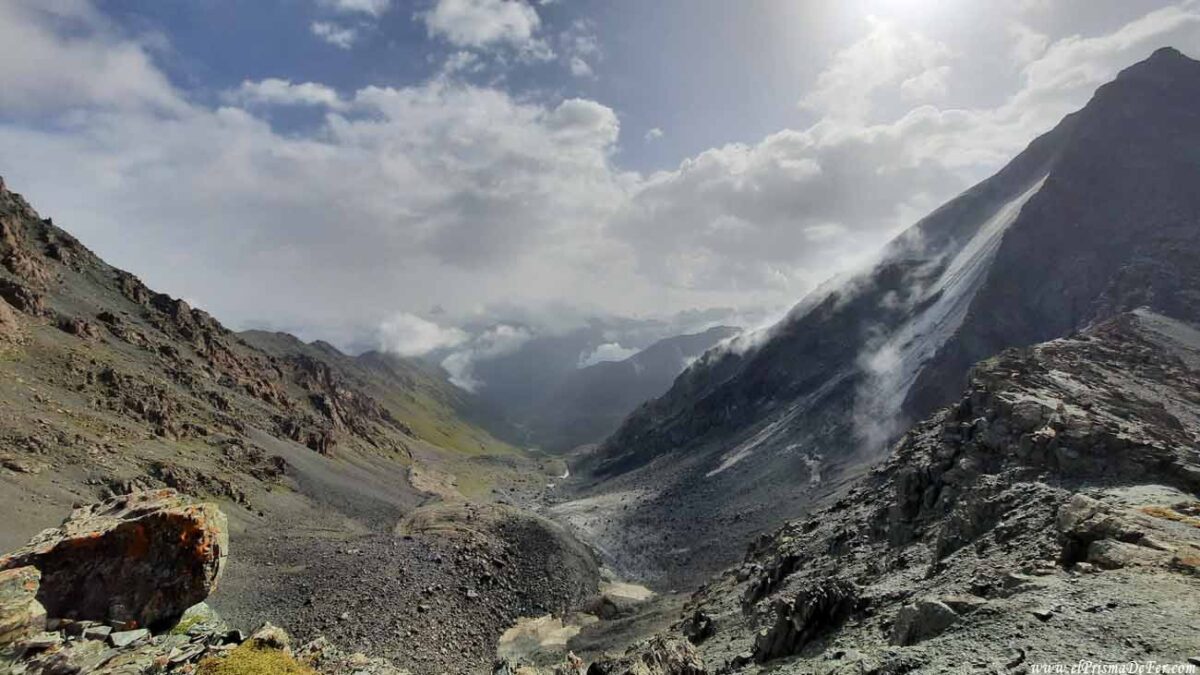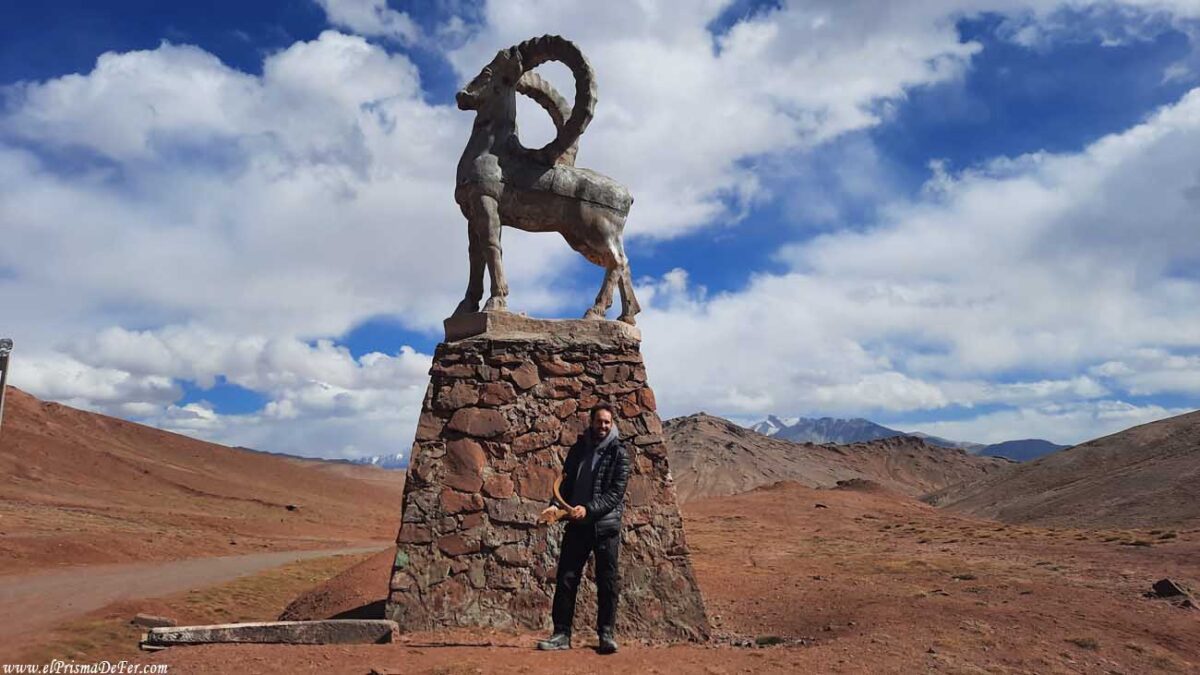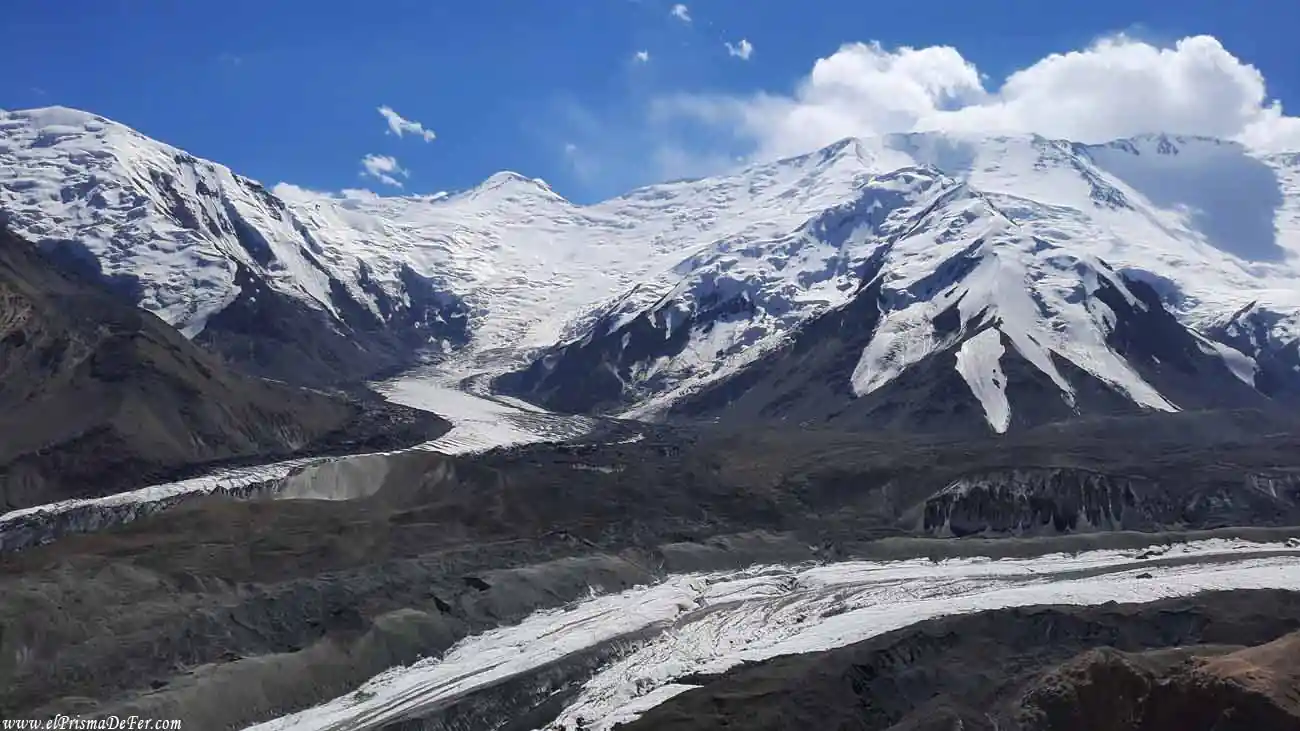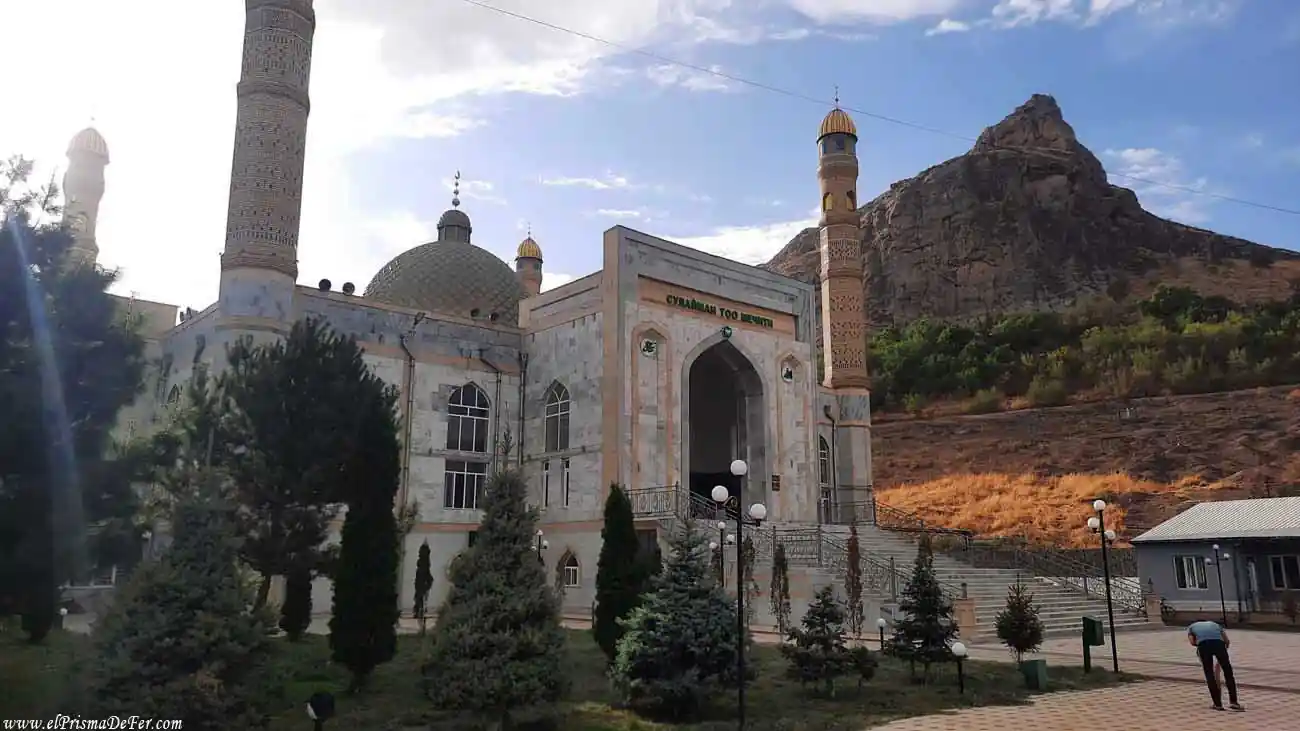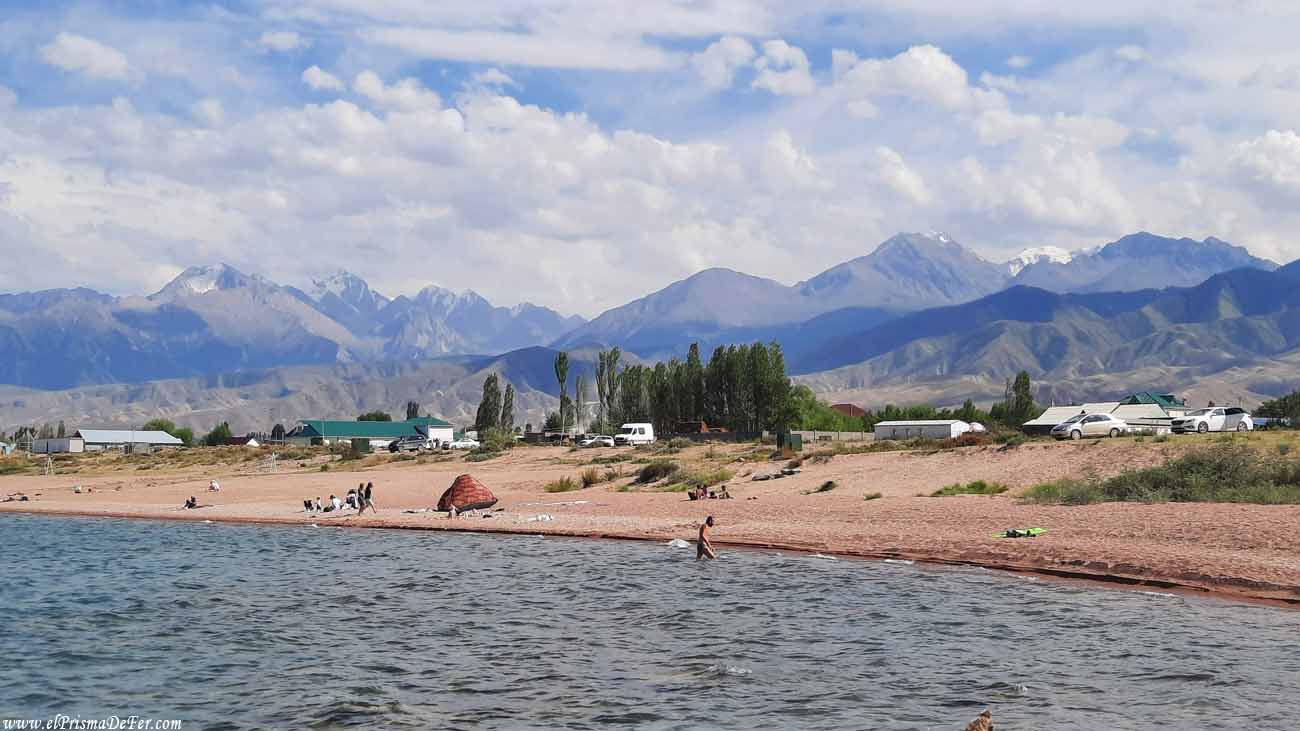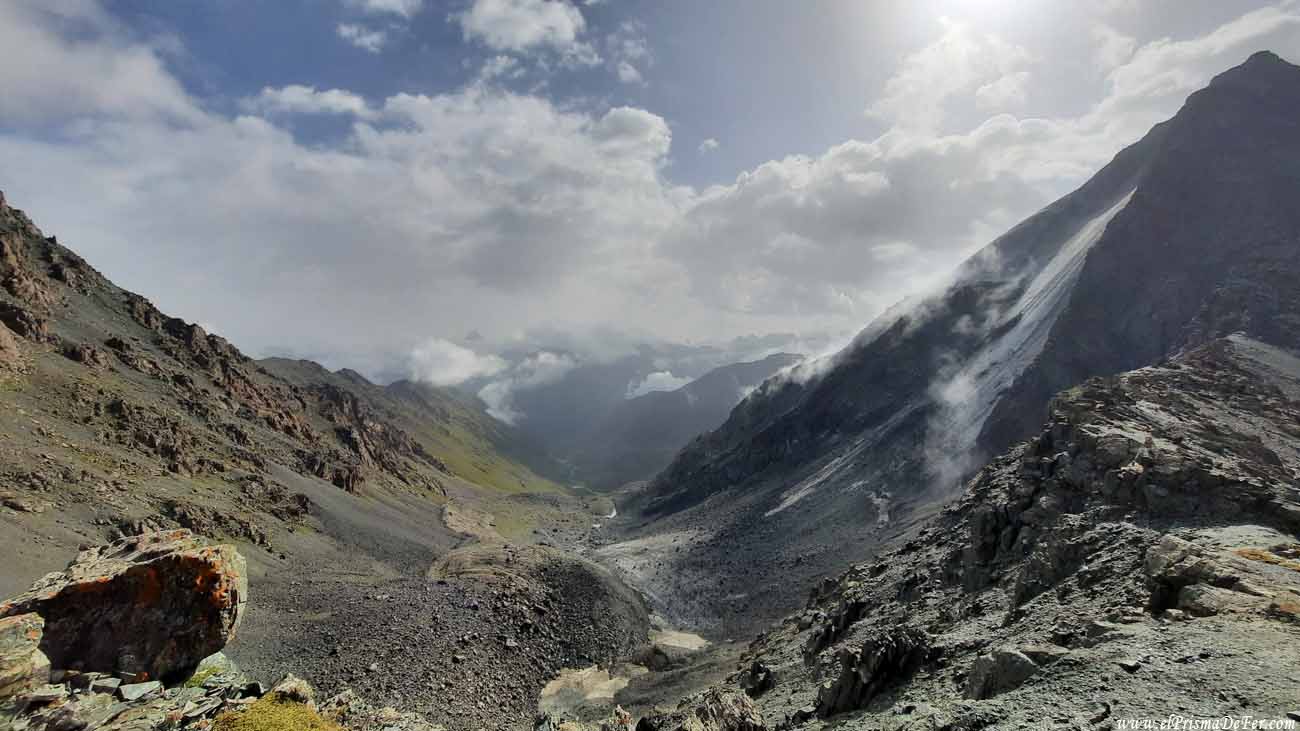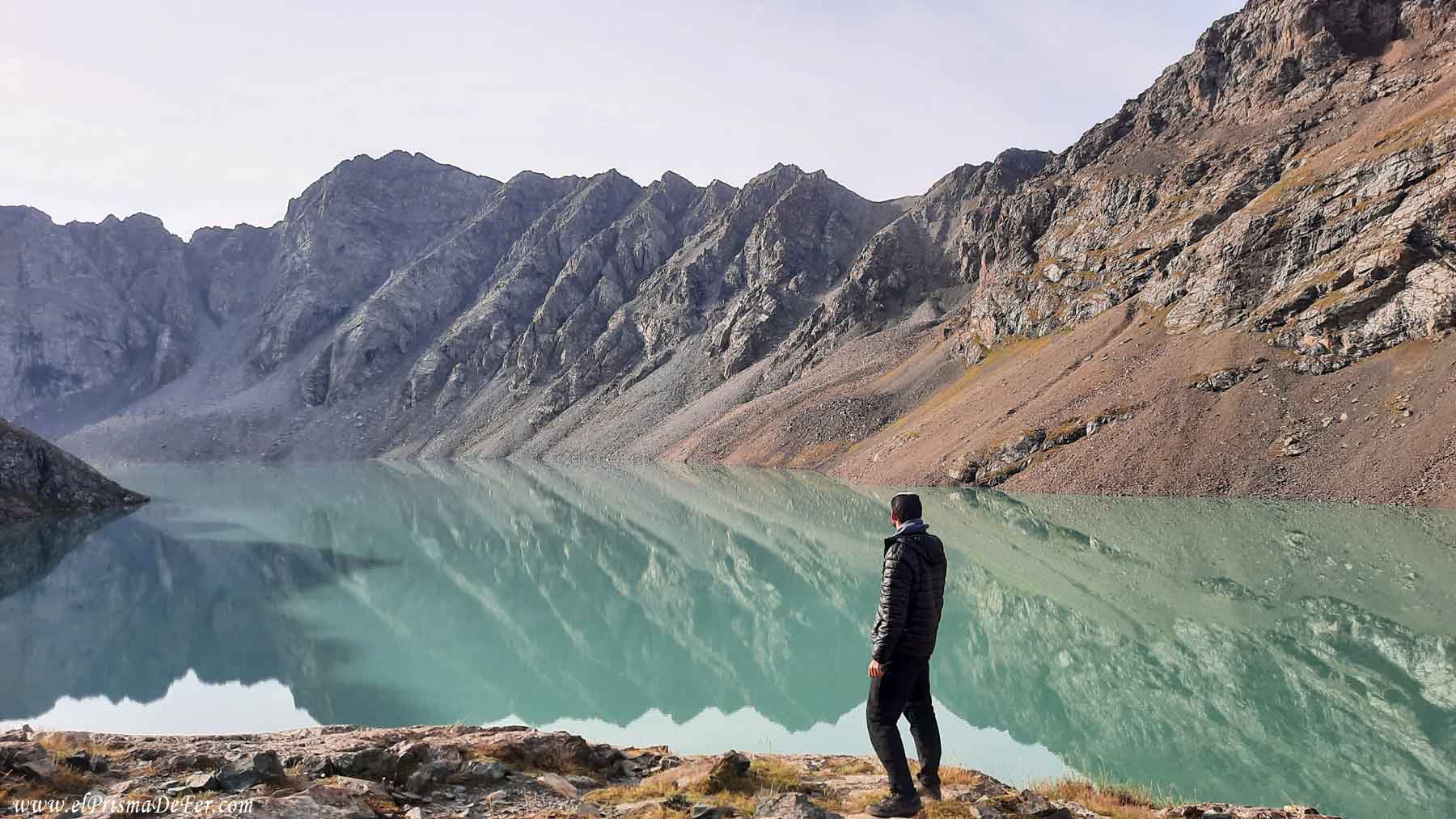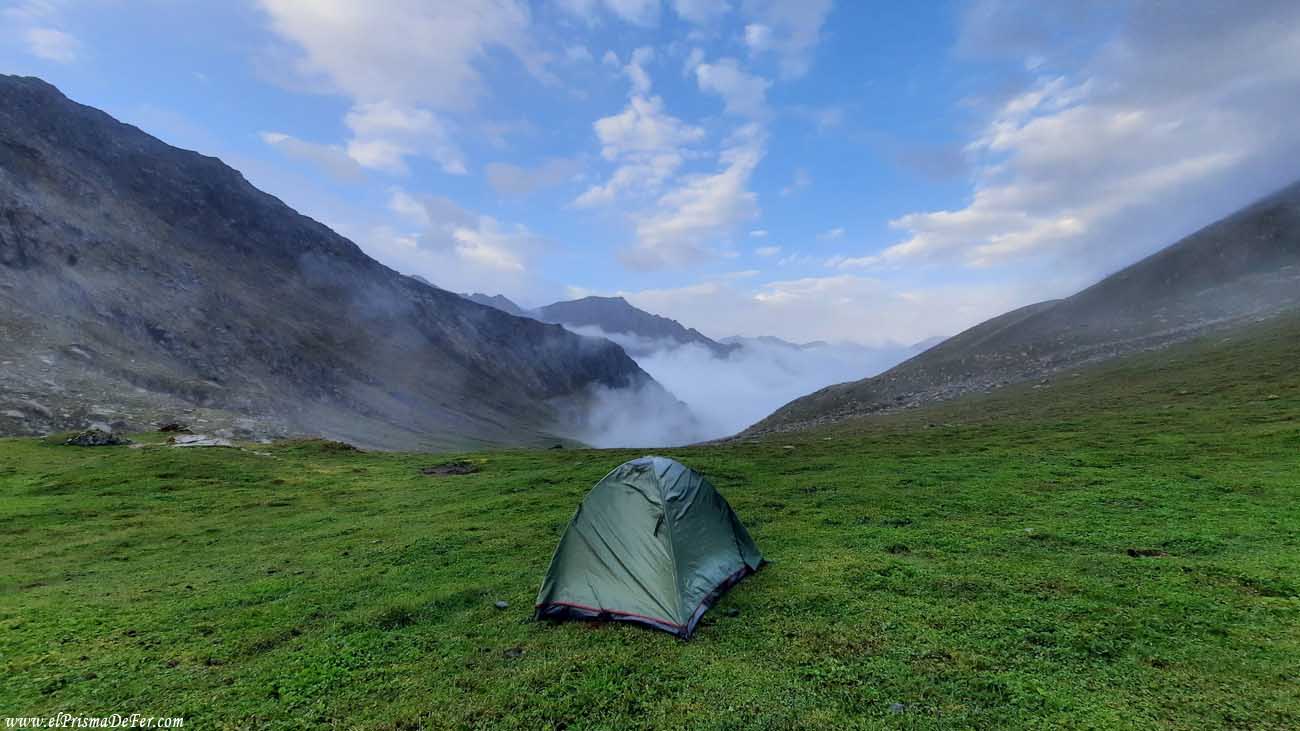Kyrgyzstan was one of the great surprises of my trip through Central Asia. A mountainous, wild, and hospitable country, where yurts, nomadic shepherds, and alpine lakes are part of the everyday landscape. Although sometimes overshadowed by its more visited neighbors, such as Uzbekistan, Kyrgyzstan offers a perfect combination of pristine nature, traditional culture, and outdoor adventure, making it one of the best places for those looking to get off the beaten path.
In this guide, you'll find all the information you need to travel around Kyrgyzstan on your own: from how to get around, what places to visit, when to go, and what to keep in mind to make the most of your time in this corner of the world. If you love mountain landscapes, trekking, rural life, and authenticity, Kyrgyzstan is sure to earn a place on your list of favorites.

Table of Contents
What to know before traveling to Kazakhstan
| Language 🗣️ |
| The official language is Kyrgyz, but Russian is also widely spoken and used on signage, especially in cities. English is rare outside tourist areas, although younger people or those working with travelers often have a basic command of it. |
| Currency 💵 |
| The local currency is the Kyrgyz som (KGS). There are ATMs in major cities and towns, as well as currency exchange offices. However, it is recommended to carry cash, especially when traveling in remote areas where cards are not accepted. |
| Religion ☪️ |
| The majority of the population is Sunni Muslim, but Kyrgyzstan is a very secular and tolerant country. Generally, there is no need to modify behavior or dress beyond what is required out of respect in more traditional places of worship or rural areas. |
| Location 📍 |
| Kyrgyzstan is a landlocked country located in the heart of Central Asia, bordering Kazakhstan, Uzbekistan, Tajikistan , and China. It is completely covered by mountains, with over 90% of its territory located at altitudes above 1,500 meters above sea level, making it a paradise for trekking and wildlife lovers. |
| Capital 🏙️ |
| The capital is Bishkek, a Soviet-influenced city that is often the gateway to the country. Although not particularly attractive, it's a good place to organize your trip, rest, withdraw money, and process permits if you plan to explore border areas. |
| Visa 🛂 |
| Kyrgyzstan has a fairly flexible visa policy. Many countries, including most in Europe, Latin America, and North America, do not require a visa for stays of up to 60 days. For longer stays, visa extensions are possible within the country or by exiting and re-entering. |

My trip to Kyrgyztan was part of a long journey along the ancient Silk Road. In this post, you can learn more about the countries I visited and how to do it all on your own.
Map of Kyrgyzstan
📖 A Brief History of Kyrgyzstan
The history of Kyrgyzstan is deeply marked by its nomadic nature and its strategic location on the trade routes of Central Asia. For centuries, these lands were home to nomadic Turkic tribes, who moved through the Tien Shan Mountains with their yurts, horses and herds. While there were attempts to establish more defined state structures, the nomadic lifestyle prevailed well into the 20th century.
Due to its location, Kyrgyzstan was part of the ancient Silk Road, and many caravans passed through its mountain passes on their way to China or the Middle East. Over the centuries, the region was dominated by various empires: first the Persians and Arabs, then the Mongols, and later Turkic khanates like Kokand.
Russian Empire and USSR
At the end of the 19th century, the Russian Empire annexed the territory, bringing with it a strong Slavic and Orthodox influence. Later, after the Russian Revolution, Kyrgyzstan joined the Soviet Union as a socialist republic, a period that completely transformed the country: populations were settled, education and industry were promoted, and nomadism was forced to decline.

Finally, in 1991 Kyrgyzstan declared its independence after the fall of the USSR. Since then, it has undergone complex political transitions, with popular revolutions and changes of government, but has remained one of the most open and safe countries for tourism in the region.
Today, Kyrgyzstan retains a unique identity, blending Soviet influences, Islamic traditions, and a vibrant nomadic heritage, especially visible in rural areas.

👥 What are the Kyrgyz people like?
Kyrgyz people tend to be quiet, respectful, and hospitable, especially outside of large cities. At first glance, they may seem reserved, but a smile or a gesture of interest is enough to make them warmly welcome you. In rural areas, it's common for them to invite you over for tea, a meal, or even to spend the night, even if they don't speak a word of English. Hospitality is an essential part of their culture, inherited from their nomadic tradition.

Physically, many Kyrgyz have Asian features, but it is surprising to see a great diversity: some have light eyes, light skin, and mixed features that reflect centuries of influences between Turkic, Persian, Russian, and Mongolian peoples. This blend is also felt in their everyday culture.
And although they are mostly Muslim, the Soviet legacy is still very present in many customs. One of them: vodka. It's not uncommon to consume it at family or friends gatherings, even in the middle of the afternoon. I remember in Tosor, a small town on the shores of Lake Issyk-Kul, that some local families staying at the same guesthouse invited me to toast… and they didn't stop all day. It was impossible to refuse so many glasses with the classic "salamát" (cheers!).

🚆 How to get around Kyrgyzstan
Traveling through Kyrgyzstan is fairly straightforward on the main routes, but it can be more adventurous if you plan to get off the beaten track. These are the most common options:
1. Marshrutkas (minibuses)
- Popular routes: Bishkek–Osh, Bishkek–Karakol, Balykchy–Naryn, among others.
- Frequency: They come out when they are full, throughout the day.
- Price: Very economical (300 to 800 KGS depending on the distance).
- Tip: Reservations are not required on busy routes, but on secondary routes it is best to confirm the schedule the day before.
2. Shared taxi
- They operate informally, grouping passengers who share a ride.
- They are located at the same marshrutka terminals or in central areas.
- Price: From 500 to 1,500 KGS depending on distance and number of passengers.
- Tip: Negotiate the price well before getting in.
3. Private Taxi
- Ideal if you want comfort or are short on time.
- Cost: Between 3,000 and 10,000 kg or more for long journeys.
- It can be arranged through travel agencies such as CBT (see below), hostels, or apps such as Yandex Go.
4. Car rental
- It offers complete freedom, especially for exploring lakes, valleys or grazing areas.
- Requires experience driving in mountains and dirt roads.
5. Hitchhiking
- Very common among backpackers, especially in areas where transportation is scarce.
- My experience: For example, to get to Susamyr from Kochkor, there were no marshrutkas or shared taxis. I ended up hitchhiking, and it was the only way to get there, although some charged me. The same thing happened when I wanted to go from Susamyr to Osh: there is no direct transport and I had to make a series of trips with local drivers.
- Tip: On less-traveled stretches, be patient, start early, and bring snacks and water.
6. Plane or train (for specific cases)
- The plane is only useful for saving time on long routes (such as Bishkek–Osh).
- Unlike its neighbors Kazakhstan and Uzbekistan, in Kyrgyzstan the rail network is limited and divided into two unconnected sections: one in the north, running from Bishkek to Balikchi, and another in the south. Trains are slower but economical and scenic if you have time.
- This is the link to the official website for purchasing train tickets in Kyrgyzstan. For example, to buy the Bishkek-Balikchi section, you would need to enter ст. Бишкек-2 (Bishkek 2) – ст. Рыбачье (Rybach’ye) in the search engine.
Conclusion: In urban areas and tourist hubs, transportation is accessible and affordable. But if you're planning to explore remote villages, rarely visited valleys, or routes like Susamyr–Osh, be prepared to improvise: hitchhiking or negotiating private transportation may be the only option. This mix of adventure and uncertainty is also part of the charm of traveling in Kyrgyzstan.
🥾 What is trekking like in Kyrgyzstan?
Trekking in Kyrgyzstan is, without a doubt, one of the best ways to connect with the country's nature. Its mountains are wild, remote, and spectacular, and the best part is that many of them still feel unexplored. If you like hiking, this country will blow your mind.

One of the main features is that you don't need special permits or a mandatory guide. Many of the most popular treks (such as Ala-Kul or Song-Kul) can be done independently, with offline maps, some planning, and basic equipment. Access is free, and that gives you a sense of adventure and freedom that not all destinations offer.
Along the way, you'll find nomadic yurts where you can sleep and eat, especially during the high season (summer). But if you have a tent, you can also camp freely, surrounded by pure nature. Of course, keep in mind that the weather can change abruptly, and that you are at altitude.
An important detail: there are many rivers to cross, and not all of them have bridges. Some involve crossing over rocks, others involve wading through knee-deep water. I even had to pay a local to take me across on his horse. Wearing good footwear, walking sticks, and being careful at crossings is key.

In short: Trekking in Kyrgyzstan is wild, accessible, and deeply rewarding. It requires some self-sufficiency and a sense of adventure, but the scenery and experience more than make up for it.
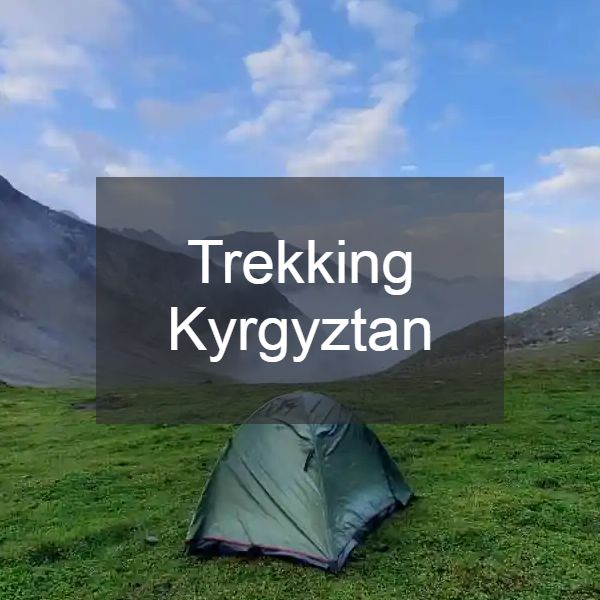
Do you want to follow all the routes precisely?
Download the KML/KMZ files for each trek I did in Kyrgyzstan and open them in apps like Maps.me or Gaia GPS to view the complete routes offline. Ideal if you want to navigate the valley with confidence, even without a signal.
Download each route on the Gumroad platform for a small contribution:
🏔️ What is CBT and why can it help you travel around Kyrgyzstan?
If there is a key organization for moving around Kyrgyzstan, especially in rural areas and for trekking, it is the CBT (Community Based Tourism). This agency is present in almost the entire country, and its main objective is to promote sustainable tourism that directly benefits local communities.
CBT works like a local networking site, and is ideal if you want to:
- Sleep in authentic yurts, in shepherds' camps, or in family homes.
- Organize excursions or treks (on horseback or on foot), with local guides.
- Get shared transportation to remote areas.
- Obtain reliable information on road conditions or the logistics of less-traveled routes.
While it's not always the most economical option, it can often be the easiest and safest way to organize less-traveled routes.
For example, I used the CBT agency in Kochkor to arrange transportation from the city to the start of the trek to Song Kul Lake. And while they can sometimes be a bit informal, they are almost always super friendly and have a solution at hand.
You can find them in physical offices (there are some in Karakol, Kochkor, Osh, Naryn, etc.) or search for them online. Many local accommodations also partner with CBT, so you can check directly with your guesthouse or campsite.
🧭 Fun facts about Kyrgyzstan
A country of yurts and modern nomads
Although most Kyrgyz today live in cities or towns, many families still maintain nomadic traditions and spend their summers in the mountains, living in yurts (traditional circular tents). During your trip, it's common to see these white structures on grasslands at over 3,000 meters above sea level.

Kumis: fermented mare's milk 🐴
kumis is the national drink and one of the most challenging flavors for travelers. It's made from fermented mare's milk and has a tangy, frothy, and slightly alcoholic taste. For many locals, it has medicinal properties and is a symbol of hospitality.
A lake that never freezes ❄️
Issyk-Kul, one of the largest alpine lakes in the world, is at an altitude of 1,600m and, although it is surrounded by snow-capped mountains, never freezes, thanks to its salinity and depth. Its name, in fact, means "hot lake."

Manas: The Eternal Epic Hero
The epic poem “Manas” is one of the longest oral texts in the world. It narrates the exploits of the national hero Manas, and his legacy is so significant that there are monuments, universities, and even an airport named after him.

The Kyrgyz carpet has its own name
Traditional “shyrdaks” are felt rugs decorated with geometric motifs. They are handmade using techniques passed down from generation to generation, and each design has a meaning. You can see them in markets or in the yurts themselves.

The national sport is horseback riding 🐎
Kok-boru is a type of extreme polo in which riders, mounted at full speed, compete to throw the body of a headless goat (yes, you read that right) into a goal. It's played at festivals and celebrations and is a cultural spectacle.

One of the most unique flags in the world
The flag of Kyrgyzstan shows a sun with 40 rays (representing the 40 legendary tribes that united under Manas) and in the center is the toono, the circular crown of the yurt, seen from below. It is a symbol of home and nomadic identity.


🏔️ What to see and do in Kyrgyzstan?
Kyrgyzstan is a country of epic landscapes, nomadic culture, and authentic hospitality. Although it is not very large, it offers an incredible variety of experiences for nature and mountain lovers. Here are some of our most recommended stops:
🏙️ Bishkek, the capital of Kyrgyzstan

The modern, Soviet-style capital is the most common entry point into the country. While not Kyrgyzstan's main attraction, it does have tree-lined avenues, markets like the Osh Bazaar, cafes, and nightlife. It's a great place to organize your trip or rest between journeys.
🏞️ Karakol and trekking in the Tian Shan Mountains

One of the most important mountaineering bases in the country. From here you can do famous treks like the one to Ala-Kul passing through Altyn Arashan or a less popular one leaving from Kyzyl-Suu to Jeti-Oguz, crossing the Archa-Tor mountain pass, visit the Issyk-Kul Lake or the Dungan Mosque. The natural surroundings are spectacular, with snow-capped mountains and green valleys.
🏖️ Surroundings of Lake Issyk-Kul
Lake Issyk-Kul, one of Kyrgyzstan's greatest natural treasures, stands out not only for its size (it's the second largest saline lake in the world) but also for the contrast between its two main shores: the northern shore and the southern shore. Both offer very different experiences, so it's worth deciding where to explore based on your travel needs.
North coast: the most touristic
The northern part of the lake, especially in towns like Cholpon-Ata, is much more developed for local tourism. It is an area full of resorts, private beaches, restaurants and nightclubs, very popular with Kyrgyz and Kazakhs during the summer. While the natural surroundings are still beautiful, it's worth noting that it's more crowded, more urban, and less authentic to the country's rural lifestyle.
South coast: quiet villages and pure nature

The south coast, on the other hand, is ideal if you're looking for peace and quiet, contact with locals, and more rugged landscapes. Small towns like Tosor or Kaji-Say offer a much more leisurely pace. From there, you can visit unique places like Skazka Canyon (Fairy Tale Canyon), with its colorful rock formations that look like they're from another planet.
In addition, the south coast is an excellent base for hiking in the nearby valleys, enjoying more secluded beaches, or simply stopping to observe the immensity of the lake without crowds around.
🐴 Kochkor and trekking to Song-Kul

Kochkor is the gateway to one of the country's most iconic sites: the Song Kul Alpine Lake, surrounded by shepherds and yurts. From here, you can organize trekking trips on horseback or on foot, and sleep with local families high above.
🕌 Osh

The oldest city in the country, with over 3,000 years of history. It has a more Uzbek feel, lively markets, and the Sulaiman-Too Mountain, a sacred site with panoramic views. It's also a good point to cross into Uzbekistan or begin the Pamir Highway.
🐏 Susamyr
A remote, rural region in the center of the country. It doesn't have many "attractions" as such, but its essence lies in the steppe landscape, nomadic families, and solitude. Ideal if you're looking for an off-the-beaten-track experience.

🏔️ Sary-Mogul and trekking to Lenin Peak
An epic spot for mountaineering enthusiasts. From Sary-Mogul you can access the base camp of Lenin Peak (7,134m). Even if you're not planning to climb, there are accessible treks with stunning views of the glacier and mountains.

The surrounding landscape is beautiful: endless meadows, snow-capped mountains, and a constant wind that reminds us of the inhospitable nature of the area.
🏞️ Sary-Tash: a crossroads in the heart of the Pamirs
Sary-Tash is a small town in southern Kyrgyzstan, located at a strategic crossroads between three countries: Kyrgyzstan, Tajikistan, and China. Although the place itself does not have much to see, its importance lies in its location, as it is a must-see if you plan to cross towards the Pamir Highway via the Kyzyl-Art Pass, or if you are coming from China via the Irkeshtam Pass.
🧭 Other places in Kyrgyzstan that I still have to visit
Although I traveled through much of the country during my trip, Kyrgyzstan has many other interesting corners that, due to time or logistics, I didn't get to see, but that several travelers recommended to me:
🌳 Arslanbob and the walnut forests
This town, located in the southwest of the country, is famous for being surrounded by the largest walnut forest in the world. The combination of conservative Muslim culture, mountainous landscapes, and forest trails make it an ideal place for those seeking nature and local life.
🏰 Tash Rabat
An ancient caravanserai located in a secluded valley at an altitude of over 3,000 meters, Tash Rabat is a symbol of the Silk Road and can be visited from Naryn.

🏞️ Lake Kel-Suu
This hidden lake, located on the border with China, is considered by many to be the most spectacular place in Kyrgyzstan. Access is not easy: a 4×4 vehicle and special permits are required, but the views of the lake between rock canyons seem out of this world.
Organized activities in Kyrgyztan

🍽 Typical food from Kyrgyzstan
Kyrgyz cuisine is a blend of nomadic traditions and Central Asian flavors. Meat (especially lamb and beef), flour, and dairy products predominate.
🥩 Beshbarmak
The national dish par excellence. It means "five fingers," as it is traditionally eaten with the hand. It is made with boiled meat (usually lamb or horse) served on a bed of boiled pasta sheets, accompanied by onions cooked in broth. It is common at celebrations and family gatherings.

🍲 Laghman
Homemade noodles with sauce, vegetables, and meat. A tasty and very common dish.

🥟 Manti
Large steamed ravioli filled with minced meat and onion. They are similar to Uzbek or Chinese dumplings, but larger. They are sometimes served with sour cream or hot sauce.

🥩 Shashlik
Grilled meat skewers, very common in markets and restaurants. They can be made with lamb, beef, chicken, or liver, and are usually accompanied by bread and raw onions.

🥛 Kumis
Traditional fermented drinks: kumis is made from mare's milk. It's sour and frothy, not suitable for all palates, but an essential part of the local culture.
🌍 How to cross from Kyrgyzstan to neighboring countries?
Kyrgyzstan borders Kazakhstan, Uzbekistan, Tajikistan, and China, and most of its border crossings are open to foreign travelers. Below are the main crossing options:
🇰🇿 Kyrgyzstan – Kazakhstan
Most common border: Bishkek – Almaty through the Korday pass.
- Very easy to do by land. From Bishkek's western station, marshrutkas leave directly to the border crossing.
- The crossing is on foot (a few minutes) and then you take transport from the Kazakh side to Almaty.
- Other borders: Talas – Taraz (less used), and in the northeast, near Karakol.
🇺🇿 Kyrgyzstan – Uzbekistan
Most common crossing: Osh – Andijan via the Dostuk pass.
- You can take a shared taxi from Osh, which will drop you off at the border. You walk across, and on the Uzbek side, you take another taxi to Andijan or Tashkent.
- From Jalal-Abad or Batken there are also border crossings, although they are less crowded.
- Overall, the crossing is quick and uncomplicated.
🇹🇯 Kyrgyzstan – Tajikistan
Most famous pass: Sary-Tash – Karakul through the Kyzyl-Art Pass, within the Pamir Highway.
- It is a spectacular and high pass (4,280m), ideal for those who want to travel the Wakhan Valley or the Pamir Route.
- Important: To enter Tajikistan via this route, you need the GBAO permit and another permit to present at the Kyrgyzstan border, which you can obtain online along with the visa or ask an agency to process it for you (I wrote a Guide to crossing this border, with everything you need to know).
- Although this border was closed for several years, it was reopened and operational only a few years ago, for foreigners only. I was able to cross it without any problems.
🇨🇳 Kyrgyzstan – China
Pass enabled: Irkeshtam Pass, near Sary-Tash.
- Route used to connect with Kashgar (Xinjiang).
- The crossing is open, but tightly controlled. It can only be accessed by public transport (not on foot).
- It is recommended to have a Chinese visa pre-arranged and confirm any restrictions based on your nationality.
- Alternatively, the Torugart pass also exists, but is even more restricted.
General advice: Always check the current status of the borders before traveling, as they may be temporarily closed for political or weather reasons. It's also important to note that mountain passes may be closed in winter due to snow accumulation.
Best time to travel to Kyrgyzstan
The best time to visit Kyrgyzstan is from June to September, when temperatures are pleasant even in the high mountains and all roads are open. This is the ideal time for trekking, sleeping in yurts, and enjoying alpine lakes like Song Kul or Issyk Kul.
I was there between August and September, and it was perfect. Although there were some cool days, especially at altitude, all the trails were walkable. However, by late September, some yurt camps were being emptied, and there were few accommodation options in the mountain areas.
- Spring (April–May): Nature begins to bloom, but many mountain trails are still closed due to snow.
- Summer (June–August): Ideal weather for outdoor adventures. Can get hot in the south.
- Early fall (September): Fewer tourists, autumn colors, and still good weather in much of the country.
- Winter (November–March): Only recommended if you're interested in skiing or experiencing snow in areas like Karakol. Most rural routes are closed.

Is it safe to travel to Kyrgyzstan? 🛡️
Yes, Kyrgyzstan is a fairly safe country for travelers. The local people are hospitable and friendly, even in very remote areas.
- Violent Crimes: Very rare. In larger cities, petty theft may occur, but it is not common.
- Police corruption: I have not had any experiences or heard of any problems with the police.
- Traveling alone: Completely possible, even hitchhiking or camping.
- Areas to avoid: Some border areas with Tajikistan may be closed or restricted from time to time, but travelers can usually get around safely if they follow established routes.
Is it expensive to travel in Kyrgyzstan? 💵
Kyrgyzstan is a budget-friendly destination, ideal for backpackers or budget travelers.
- Accommodation: From $6 to $10 in basic hostels or shared yurts. A comfortable guesthouse can cost between $12 and $25.
- Food: Dining at a local restaurant costs between $2 and $5 per meal. A full meal with drinks costs $3 to $6.
- Transportation: Marshrutkas and shared taxis are very cheap. A long trip can cost between $5 and $15.
- Excursions or car rentals: This can increase your budget. A 4x4 costs around $80–100 USD per day.

Conclusion: With a budget of 25–40 USD per day you can travel very well.
Which eSIM should I use in Kyrgyzstan?
If you don't want to go through the hassle of finding a traditional SIM card as soon as you arrive in Kyrgyzstan, an excellent alternative is to use an eSIM. With this system, you can activate mobile data from your phone before traveling, without having to go to a store or change your physical card.
For those planning to travel around the country, I recommend using Airalo, as it offers cheaper plans than other companies and has coverage throughout Kyrgyzstan, although I'm not sure if it works well in remote areas or areas far from cities.
Additionally, if you buy the Kyrgyzstan eSIM through my link you can access a 15% discount if it's your first purchase (Code: NEWTOAIRALO15), or 10% if you've used the platform before (Code: AIRALOESIM10).
If you want to better understand how eSIMs work, their advantages, how to check if your phone is compatible and how to use the codes, I invite you to read the full post I wrote on the topic.
Which SIM card should I use in Kyrgyzstan?
Having a local SIM is highly recommended if you're traveling in Kyrgyzstan, especially if you plan to travel through rural areas or go trekking. The good news is that mobile data is cheap and coverage is good throughout most of the country, although coverage can be weak in mountainous areas.
🥇 The main companies are:
- Beeline
- Good overall coverage and affordable prices.
- Ideal for those who will only be in major cities or towns.
- O! (Oshka)
- Very popular with locals.
- Good signal and excellent coverage in rural areas.
- MegaCom
- The most recommended if your trip includes remote areas or mountainous zones.
- It has the best coverage in regions such as Naryn, Song-Kul or Karakol.
📱 Where to buy a SIM card?
- They can be easily purchased at Bishkek Airport, in official stores, or even at small kiosks in any city.
- You need to present your passport, but the process is quick.
- Some travel packages already include several GB of data and local calls for very low prices (from $2 to $5).
How many days do I recommend staying in Kyrgyzstan?
It will depend a lot on your travel style, whether you like to do a lot of trekking or prefer a more relaxed tour of towns and landscapes.
📆 My experience: one month
I spent a month in Kyrgyzstan, and I still had places left to visit, like Tash Rabat and explored some areas in the south in more depth. I did a lot of trekking, like in Ala-Kul, Archa Tor, Song-Kul and Lenin Peak, and spent a few days in towns like Tosor, Susamyr, Sary-Tash and Sary-Mogul, so the time flew by.

⏳ Do you have less time?
If you are going to be there for 10 to 15 days you can put together a complete tour of the north of the country, including Bishkek, Karakol, Song-Kul and Lake Issyk-Kul, plus some short trekking.
With 3 weeks it is possible to add less touristy regions such as Naryn, Arslanbob, Susamyr or the south towards Osh.
Tip: If you don't intend to do a lot of trekking or prefer not to travel so much through rural areas, you can adjust the days without losing the essence of the country, although I always recommend leaving some room for unforeseen events and to enjoy the local hospitality without rushing.
Support The Prism of Fer!
Your support helps me continue creating free content on the blog. Thank you so much!


